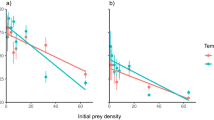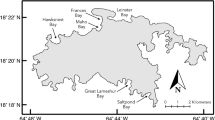Abstract
Invasive species are often more able to rapidly and efficiently utilise resources than natives, and comparing per capita resource use at different resource densities among invaders and trophically analogous natives could allow for reliable predictions of invasiveness. In South Africa, invasion by the Mediterranean mussel Mytilus galloprovincialis has transformed wave-exposed shores, negatively affecting native mussel species. Currently, South Africa is experiencing a second mussel invasion with the recent detection of the South American Semimytilus algosus. We tested per capita uptake of an algal resource by invading M. galloprovincialis, S. algosus, and the native Aulacomya atra at different algal concentrations and temperatures, representing the west and south coasts of South Africa, to examine whether their per capita resource use could be a predictor of their spread and subsequent invasiveness. Regardless of temperature, M. galloprovincialis was the most efficient consumer, significantly reducing algal cells compared to the other species when the resource was presented in both low and high starting densities. Furthermore, these findings aligned with a greater biomass of M. galloprovincialis on the shore in comparison with the other species. Resource use by the new invader S. algosus was dependent on the density of resource and, although this species was efficient at low algal concentrations at cooler temperatures, this pattern broke down at higher algal densities. This was once more reflected in lower biomass in surveys of this species along the cool west coast. We therefore forecast that S. algosus will be become established along the south coast; however, we also predict that M. galloprovincialis will maintain dominance on these shores.



Similar content being viewed by others
References
Alexander ME, Dick JTA, Weyl OLF et al (2014) Existing and emerging high impact invasive species are characterized by higher functional responses than natives. Biol Lett 10:2–6
Alexander ME, Raven HR, Robinson TB (2015) Foraging decisions of a native whelk, Trochia cinulata Linnaeus, and the effects of invasive mussels on prey choice. J Exp Mar Biol Ecol 470:26–33
Assis J, Zupan M, Nicastro KR, Zardi GI, McQuaid CD, Serrao EA (2015) Oceanographic conditions limit the spread of a marine invader along Southern African Shores. PLoS One 10(6):e0128124
Awad AA, Griffiths CL, Turpie JK (2002) Distribution of South African marine benthic invertebrates applied to the selection of priority conservation areas. Divers Distrib 8:129–145
Barrios-O’Neill D, Dick JTA, Emmerson MC et al (2013) Fortune favours the bold: a higher predator reduces the impact of a native but not an invasive intermediate predator. J Anim Ecol 83:693–701
Bax N, Williamson A, Aguero M et al (2003) Marine invasive alien species: a threat to global biodiversity. Mar Policy 27:313–323
Bosman AL, Hockey PAR, Siegfried WR (1987) The influence of coastal upwelling on the functional structure of rocky intertidal communities. Oecologia 72:226–232
Branch GM, Griffiths CL (1988) The Benguela ecosystem part V. The coastal zone. Oceanogr Mar Biol 26:395–486
Branch GM, Steffani CN (2004) Can we predict the effects of alien species ? A case-history of the invasion of South Africa by Mytilus galloprovincialis (Lamarck). J Exp Mar Biol Ecol 300:189–215
Branch GM, Odendaal F, Robinson TB (2008) Long-term monitoring of the arrival, expansion and effects of the alien mussel Mytilus galloprovincialis relative to wave action. Mar Ecol Pog Ser 370:171–183
Branch GM, Odendaal F, Robinson TB (2010) Competition and facilitation between the alien mussel Mytilus galloprovincialis and indigenous species: moderation by wave action. J Exp Mar Biol Ecol 383:65–78
Byers JE, Reichard S, Randall JM et al (2002) Directing research to reduce the impacts of nonindigenous species. Conserv Biol 16:630–640
Colautti RI, Grigorovich IA, MacIsaac HJ (2006) Propagule pressure: a null model for biological invasions. Biol Invasions 8:1023–1037
Dayton PK (1971) Competition, disturbance, and community organization: the provision and subsequent utilization of space in a rocky intertidal community. Ecol Monogr 41:351–389
De Greef K, Griffiths CL, Zeeman Z (2013) Deja vu ? A second mytilid mussel, Semimytilus algosus, invades South Africa’s west coast. Afr J Mar Sci 35:37–41
Dick JTA, Gallagher K, Avlijas S et al (2013) Ecological impacts of an invasive predator explained and predicted by comparative functional responses. Biol Invasions 15:837–845
Dick JTA, Alexander ME, Jeschke J et al (2014) Advancing impact prediction and hypothesis testing using a comparative functional response approach. Biol Invasions 16:735–753
Fanslow DL, Nalepa TF, Lang GA (1995) Filtration rates of the zebra mussel (Dreissena polymorpha) on natural seston from Saginaw Bay, Lake Huron. J Great Lakes Res 21:489–500
Filgueira R, Fernández-reiriz MJ, Labarta U (2009) Clearance rate of the mussel Mytilus galloprovincialis. I. Response to extreme chlorophyll ranges. Cienc Mar 35:405–417
Grosholz E (2002) Ecological and evolutionary consequences. Trends Ecol Evol 17:22–27
Haure J, Penisson C, Bourgrier S, Baud JP (1998) Influence of temperature on clearance and oxygen rates of the flat oyster Ostrea edulis: determination of allometric coefficients. Aquaculture 169:211–224
Keller RP, Kocev D, Džeroski S (2011) Trait-based risk assessment for invasive species: high performance across diverse taxonomic groups, geographic ranges and machine learning/statistical tools. Divers Dist 17:451–461
Kulhanek SA, Ricciardi A, Leung B (2011) Is invasion history a useful tool for predicting the impacts of the world’ s worst aquatic invasive species ? Ecol Appl 21:189–202
Leffler AJ, James JJ, Monaco TA (2012) Temperature and functional traits influence differences in nitrogen uptake capacity between native and invasive grasses. Oecologia 171:51–60
Lucas AJ, Pitcher GC, Probyn TA, Kudela RM (2014) The influence of diurnal winds on phytoplankton dynamics in a coastal upwelling system off southwestern Africa. Deep sea Res Pt II 101:50–62
Mead A, Carlton JT, Griffiths CL, Rius M (2011) Revealing the scale of marine bioinvasions in developing regions: a South African re-assessment. Biol Invasions 13:1991–2008
Miller TE, Burns JH, Munguia P et al (2005) A critical review of twenty years use of the resource-ratio theory. Am Nat 165:439–448
Molnar JL, Gamboa RL, Revenga C, Spalding MD (2008) Assessing the global threat of invasive species to marine biodiversity. Front Ecol Environ 6:485–492
Murray CC, Gartner H, Gregr EJ, Chan K, Pakhomov E, Therriault TW (2014) Spatial distribution of marine invasive species: environmental, demographic and vector drivers. Divers Dist 20:824–836
Nelson G, Polito A (1987) Information on currents in the Cape Peninsula area, South Africa. S Afr J Mar Sci 5:287–304
Newell CR, Wildish D, MacDonald B (2001) The effects of velocity and seston concentration on the exhalant siphon area, valve gape and filtration rate of the mussel Mytilus edulis. J Exp Mar Biol Ecol 262:91–111
Parker IM, Simberloff D, Lonsdale WM et al (1999) Impact : toward a framework for understanding the ecological effects of invaders. Biol Invasions 1:3–19
Pimentel D, Zuniga R, Morrison D (2005) Update on the environmental and economic costs associated with alien-invasive species in the United States. Ecol Econ 52:273–288
Ricciardi A (2003) Predicting the impacts of an introduced species from its invasion history : an empirical approach applied to zebra mussel invasions. Freshwater Biol 48:972–981
Riisgard HU, Kittner C, Seerup DF (2003) Regulation of opening state and filtration rate in filter-feeding bivalves (Cardium edule, Mytilus edulis, Mya arenaria) in response to low algal concentration. J Exp Mar Biol Ecol 284:105–127
Rilov G, Galil B (2009) Marine bioinvasions in the Mediterranean Sea—history, distribution and ecology. In: Rilov G, Crooks JA (eds) Biological invasions in marine ecosystems. Springer, Berlin, pp 549–575
Robinson TB, Griffiths CL, McQuaid CD, Rius M (2005) Marine alien species of South Africa—status and impacts. Afr J Mar Sci 27:297–306
Robinson TB, Branch GM, Griffiths CL et al (2007) Changes in South African rocky intertidal invertebrate community structure associated with the invasion of the mussel Mytilus galloprovincialis. Mar Ecol Prog Ser 340:163–171
Ruiz GM, Fofonoff P, Hines AH, Grosholz ED (1999) Non-indigenous species as stressors in estuarine and marine communities: assessing invasion impacts and interactions. Limnol Oceanogr 44:950–972
Sadchatheeswaran S, Branch GM, Robinson TB (2015) Changes in habitat complexity resulting from sequential invasions of a rocky shore: implications for community structure. Biol Invasions 17:1799–1816
Sakai AK, Allendorf FW, Holt JS et al (2001) The population biology of invasive species. Annu Rev Ecol Syst 32:305–332
Schulte EH (1975) Influence of algal concentration and temperature on the filtration rate of Mytilus edulis. Mar Biol 30:331–341
Shinen JS, Morgan SG (2009) Mechanisms of invasion resistance: competition among intertidal mussels promotes establishment of invasive species and displacement of native species. Mar Ecol Prog Ser 383:187–197
Simberloff D (2009) The role of propagule pressure in biological invasions. Annu Rev Ecol Syst 40:81–102
Simberloff D, Martin J-L, Genovesi P et al (2013) Impacts of biological invasions: what’s what and the way forward. Trends Ecol Evol 28:58–66
Smit AJ, Roberts M, Anderson RJ et al (2013) A coastal seawater temperature dataset for biogeographical studies: large biases between in situ and remotely-sensed data sets around the coast of South Africa. PLoS One 8:e81944
Sousa R, Gutiérrez JL, Aldridge DC (2009) Non-indigenous invasive bivalves as ecosystem engineers. Biol Invasions 11:2367–2385
Steffani CN, Branch GM (2003) Growth rate, condition, and shell shape of Mytilus galloprovincialis: responses to wave exposure. Mar Ecol Prog Ser 246:197–209
Steffani CN, Branch GM (2005a) Mechanisms and consequences of competition between an alien mussel, Mytilus galloprovincialis, and an indigenous limpet, Scutellastra argenvillei. J Exp Mar Biol Ecol 317:127–142
Steffani CN, Branch GM (2005b) Growth rate, condition, and shell shape of Mytilus galloprovincialis: responses to wave exposure. Mar Ecol Prog Ser 246:197–209
Van Erkom Schurink C, Griffiths CL (1991) A comparison of reproductive cycles and reproductive output in four southern African mussel species. Mar Ecol Prog Ser 76:123–134
Van Erkom Schurink C, Griffiths CL (1992) Physiological energetics of four South African mussel species in relation to body size, ration and temperature. Comp Biochem Phys A 101:779–789
Van Erkom Schurink C, Griffiths CL (1993) Factors affecting relative rates of growth in four South African mussel species. Aquaculture 109:257–273
Van Kleunen M, Dawson W, Schlaepfer D et al (2010) Are invaders different? A conceptual framework of comparative approaches for assessing determinants of invasiveness. Ecol Lett 13:947–958
Wonham MJ, Carlton JT (2005) Trends in marine biological invasions at local and regional scales: the Northeast Pacific Ocean as a model system. Biol Invasions 7:369–392
Acknowledgments
We would like to thank H. Raven, S. Sadchatheeswaran and G. and M. Branch for assistance in field sampling, and R. Adams at the Centre of Analytical Facilities, Stellenbosch University, for assistance with flow cytometry. This study was funded by the DST-NRF Centre of Excellence for Invasion Biology.
Author information
Authors and Affiliations
Corresponding author
Additional information
Responsible Editor: F. Bulleri.
Reviewed by C. L. Griffiths and an undisclosed expert.
This article is part of the Topical Collection on Invasive Species.
Rights and permissions
About this article
Cite this article
Alexander, M.E., Adams, R., Dick, J.T.A. et al. Forecasting invasions: resource use by mussels informs invasion patterns along the South African coast. Mar Biol 162, 2493–2500 (2015). https://doi.org/10.1007/s00227-015-2742-5
Received:
Accepted:
Published:
Issue Date:
DOI: https://doi.org/10.1007/s00227-015-2742-5




